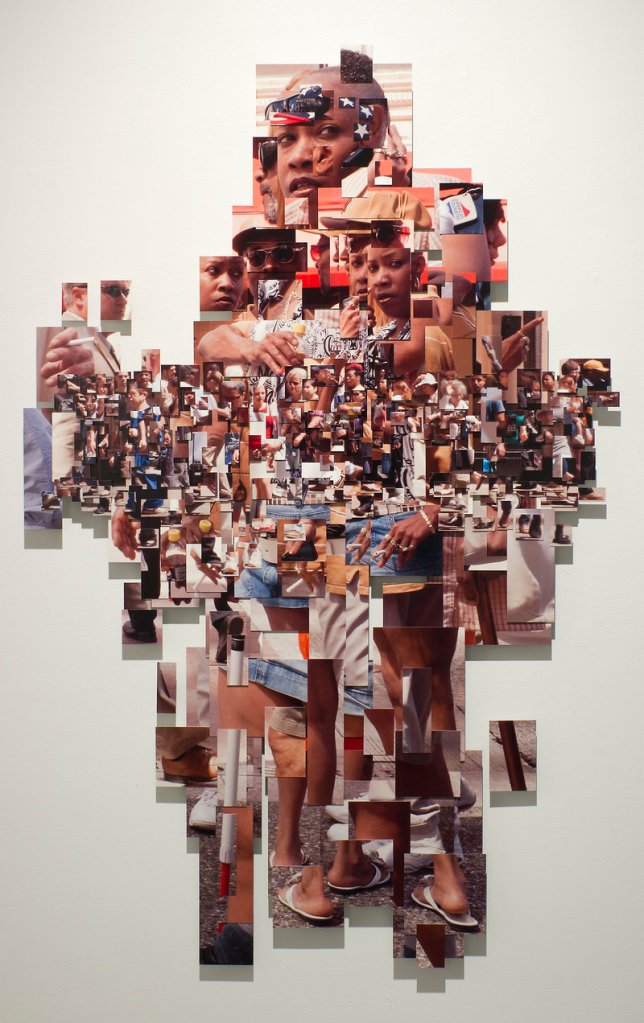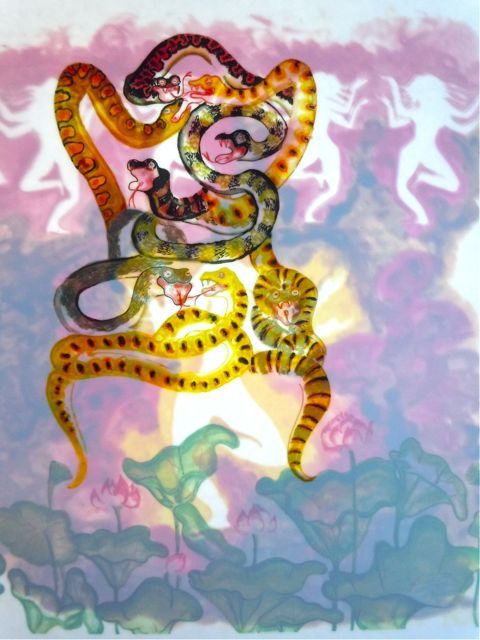Forget for a moment the academic reasons behind the 2012 Maine College of Art’s MFA Thesis Exhibition. It’s strong and interesting, and feels like a coherently curated exhibition of contemporary art.
Of course, it isn’t a thematically curated show. It’s the work of 11 graduate students.
Completely free of that self-interested, theatrical effect sometimes associated with student shows, the work is ambitious, serious and conceptually rigorous.
So what’s in the show? Eight of the artists have pictorial work; three feature fiber; two show video; several use photography; two are installation pieces; and some is hard to categorize.
I was struck by the fact that the two strong video pieces were made by artists who appear to be primarily engaged with prints and drawings.
Manjiree Manolkar’s ink on Mylar drawings of chairs comprise the bulk of her metaphorical project about power, although the drawings individually come across as fantastical meditations on natural-world themes.
Her huge woodcut “Power: Shakti” shows the power-source Mother goddess in a macabre dance on a pile of skulls while tanks and bombers roar around her. It’s hardly subtle.
Yet Manolkar’s video uses her chair drawings to spin a circular political fable about despotism and populism that manages to brilliantly balance intrigue, narrative and metaphor. She is an artist worth watching.
Anne Buckwalter’s gouache scenes also present narratives with political structures. Despite their melancholy undertones, her pictures are literally playful — depicting such themes as a game of capture the flag. They usually feature a handful of small, stylized figures divided into two sets, each set moving in a different direction. Some work, some play, others mope.
Buckwalter has a real feel for using the visual flow of her compositions to create the semblance of a narrative flow. It’s terrific work.
Wendy Love also addresses personal narrative in her weirdly humorous collage paintings about the transformation of the body by disease in a bad-trippy micro/macro universe reminiscent of photomontage pioneer Hannah Hoch.
Robin Koss’ framed etchings are technically impressive and visually complex. Their collage and layering logic subverts the myth of the suburban mastery of nature. Nature, she tacitly reminds us, will never quit.
When Koss cuts up bits of the etchings to make a larger collage, some dark imagery appears amongst the light, natural forms. Her video trio purports to show people maintaining a yard, but emits darkly Sisyphean undercurrents.
I particularly like the installation and conceptual process piece by Jessica Van Swol in which she takes a cheap, wooden toy snake and, using contemporary business and marketing approaches, documents how to produce it in clay.
The thematic, aesthetic and systems analyses result in an installation that includes 3-D models, paintings of snake-skin designs, a book, wallpaper and a pair of terrific snake-scale floor sculptures — one of felt, and the other of many hundreds of tiny ceramic elements.
It’s a process piece about reverse engineering processes, and it’s just slick enough to feel uncannily real.
Edwin Bennett’s installation is a forest scene in a U-Haul trailer (think landscape). Whatever his ecological inclinations, the piece succeeds as a commentary on the current practice of renting trailers and trucks for temporary art exhibitions and parking them at events like Portland’s First Friday Art Walk.
The simple gesture of putting the trailer in the gallery for the duration of the exhibition gives the feeling that the clock is ticking at about $15 a day. The installation’s intensity as a site of vibrant natural growth is wittily ironic against the ephemeral idea of the rental and, in turn, its self-awareness as exhibition element.
Eric Vaughn’s “Kaufmann Way #1” is a photographic piece set on 200 mutually attached aluminum rectangles. It’s an anthropomorphized street scene of people watching (faces, hands, feet, etc.) in which the images get tinier and more numerous in the middle to approximate the human-scale event horizon of the street.
This handsome (and no doubt expensive) object is fractured but rhythmically appealing, like an hour’s experience of a street musician.
Shirah Neumann’s paintings are thick and heavily worked with dense colors. The strongest — an asymmetrical diptych — immediately struck me as intelligently engaged with Gideon Bok’s work. But Neumann’s work seems a bit forced, as though process and studio practice were more important to her than the way they look.
I really like Kim Vose Jones’ installation, “I felt it shelter to speak to you.” It features a wall grouping of red airplane neck rests. These have a comically brash labial quality. The piece also includes red silk ropes (vessels and nerves?), felt (discarded clothes? Skin?), and used IV bags — empty except for the one above the large central almond form.
The whole thing is quite simply a meditation on female sexual arousal. Sure, it’s a little over-determined, but it’s a hilariously wonderful bit of feminine sexuality.
While the 2012 MECA MFA show is particularly solid and interesting, I hope it becomes the overt cultural habit of the local art audience to see as many thesis shows as possible from the likes of MECA, University of Southern Maine, University of New England, Bowdoin, Southern Maine Community College, and so on.
It would be great if the schools got together to produce a publication directory of all such shows for next year.
Freelance writer Daniel Kany is an art historian who lives in Cumberland. He can be contacted at:
dankany@gmail.com
Send questions/comments to the editors.



